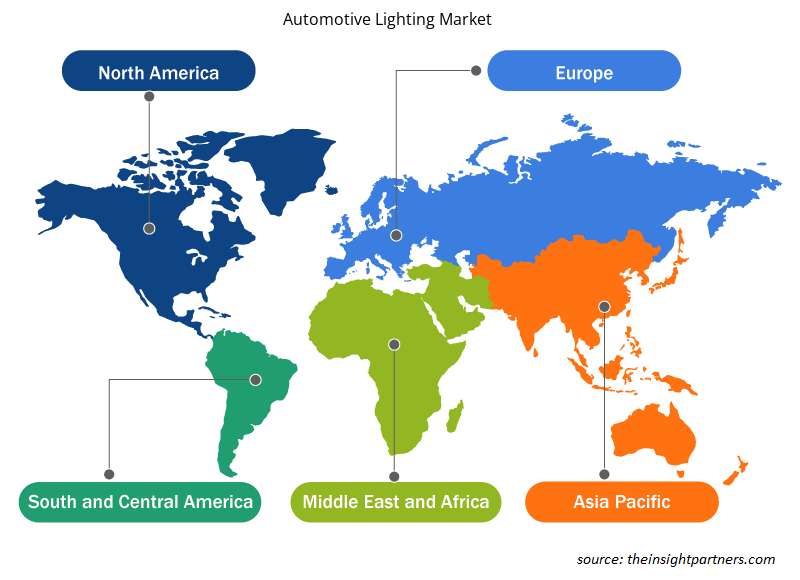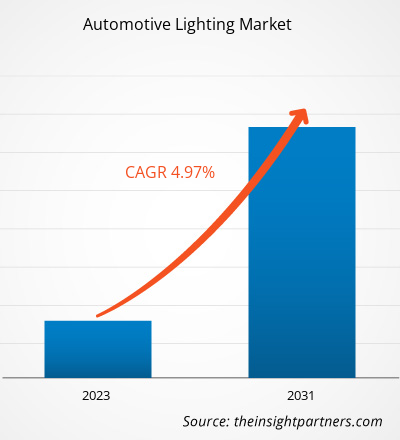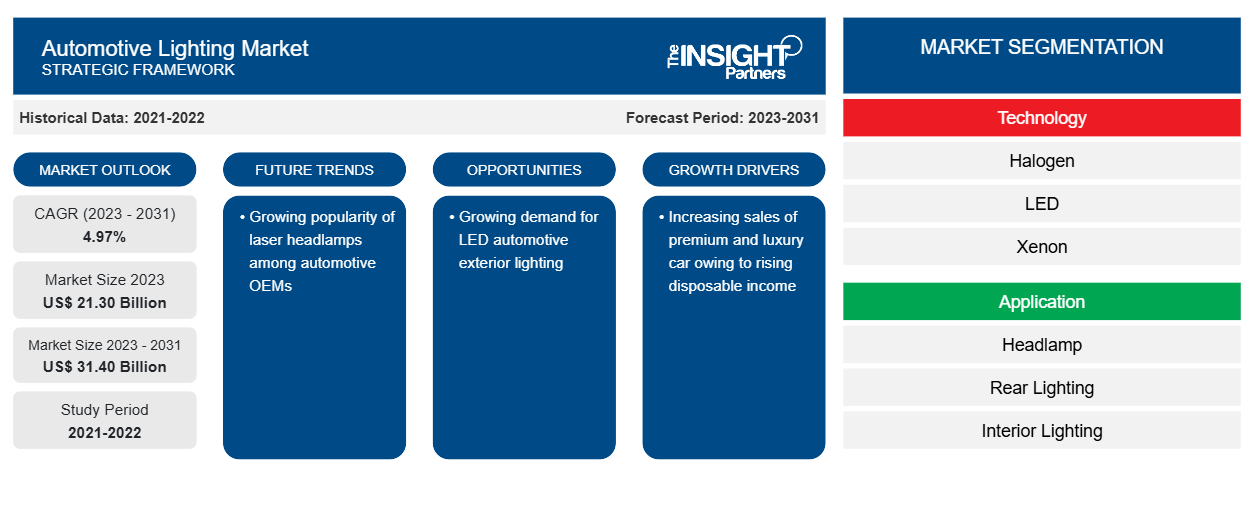자동차 조명 시장 규모는 2023년 213억 달러에서 2031년 314억 달러로 성장할 것으로 예상됩니다. 이 시장은 2023~2031년에 4.97%의 CAGR을 기록할 것으로 예상됩니다. 고급 및 고급 자동차 판매 급증이 자동차 조명 시장을 주도하고 있으며, 조명 공급업체에게도 성장 전망을 제공하고 있습니다.
자동차 조명 시장 분석
자동차 조명 생태계는 다음과 같은 주요 이해 관계자로 구성됩니다. 즉, 원자재 공급업체, 자동차 조명 제조업체/OEM 및 최종 사용자입니다. 원자재 공급업체에는 구리 , 알루미늄, LED 및 레이저 다이오드와 같은 자동차 조명에 대한 주요 원자재 구성 요소를 제공하는 공급업체가 포함됩니다. Osram-Continental, Lumileds, Hella, Valeo 및 Automotive-Lighting과 같은 자동차 조명 제조업체/OES는 다양한 유형의 차량 유형에 대한 자동차 조명을 통합하고 개발합니다. 자동차 OEM은 차량별 헤드라이트, 테일라이트 및 신호등 또는 청사진을 공급업체와 공유합니다. 공급업체는 공급업체의 계약을 위해 입찰하기 위해 고유한 견적을 제시합니다. 선택된 공급업체는 입찰 계약 기간 동안 차량별 조명 시스템을 제공합니다. OEM은 이러한 조명 구성 요소를 최종 차량에 통합합니다.
자동차 조명 시장 개요
현재 LED 매트릭스 조명 솔루션이 전체 자동차 조명 구현을 지배하고 있습니다. 매트릭스 레이저 기술은 고해상도 특성을 통해 도로 조명을 더욱 향상시킬 것으로 예상됩니다. 매트릭스 레이저 기술은 하이빔 램프용 LaserSpot을 기반으로 합니다. 매트릭스 레이저 기술을 사용하면 승용차 헤드램프에 프로젝터 기술을 수렴할 수 있게 되었습니다. 레이저의 휘도 계수는 시중에서 판매되는 다른 광원보다 약 5배 더 높으므로 레이저 헤드램프는 차량 운전자에게 더 높은 빔 범위를 제공합니다. 일반적인 레이저 헤드라이트의 빔 범위는 500m 이상입니다. BMW i8과 BMW 7은 레이저 통합 헤드라이트를 특징으로 하는 다른 승용차 시리즈입니다.
귀하의 요구 사항에 맞게 이 보고서를 사용자 정의하세요
이 보고서의 일부 또는 국가 수준 분석, Excel 데이터 팩을 포함하여 모든 보고서에 대한 사용자 정의를 무료로 받을 수 있으며 신생 기업 및 대학을 위한 훌륭한 혜택과 할인 혜택을 이용할 수 있습니다.
-
이 보고서의 주요 시장 동향을 알아보세요.이 무료 샘플에는 시장 동향부터 추정 및 예측까지 다양한 데이터 분석이 포함됩니다.
자동차 조명 시장 동인 및 기회
가처분 소득 증가로 인해 고급차 및 고급 승용차 판매 증가
소비자의 가처분 소득이 큰 선진국에서는 자동차 인구가 증가함에 따라 승용차 구매에 대한 소비자 선호도가 다르다는 것이 목격되었습니다. 결과적으로 비용 및 연료 효율성은 더 이상 이러한 자동차 구매의 주요 기준이 아닙니다. 대신 구매는 제공되는 편안함과 사치에 더 많이 의존합니다. 게다가 소비자는 선택을 할 때 조명 시스템과 자동차 인체공학을 점점 더 평가하고 있습니다.
LED 자동차 외장 조명에 대한 수요 증가
영어: National Highway Traffic Safety Administration(NHTSA)의 데이터에 따르면, 승용차 의 야간 주행 시간은 총 주행 시간의 25%에 불과하지만, 모든 승용차 사망자의 약 50%가 어둠 속에서 발생합니다. 이는 주로 도로에서의 부적절한 가시성과 부적절한 조명, 차량 헤드램프에서 제공되는 불충분한 조명 때문입니다. 안전 문제로 인해 자동차 제조업체는 더 안전한 대안을 찾게 되었습니다. OSRAM의 LEDriving 안개등은 혁신, 디자인 및 성능 면에서 주목할 만합니다. 게다가 Philips는 LED 안개등에서 생성되는 열을 제어하는 데 도움이 되는 AirFlux 및 AirCool 기술을 제공합니다. 이는 조명의 중요한 구성 요소에서 열을 차단하여 내열성을 높이고 LED의 수명을 효과적으로 연장하는 스마트 냉각 시스템입니다.
자동차 조명 시장 보고서 세분화 분석
자동차 조명 시장 분석에 기여한 주요 세그먼트는 기술, 응용 프로그램 및 차량 유형입니다.
- 기술에 따라 자동차 조명 시장은 할로겐, LED, 제논, 레이저로 구분되었습니다. LED 세그먼트는 2023년에 더 큰 시장 점유율을 차지했습니다.
- 자동차 조명 시장은 적용 분야별로 헤드램프, 리어 조명, 실내 조명, CHMSL, 안개등, 소형 램프로 세분화됩니다. 헤드램프 부문은 2023년에 시장에서 가장 큰 점유율을 차지했습니다.
- 차량 유형에 따라 자동차 조명 시장은 승용차, LCV, MCV & HCV로 구분되었습니다. 승용차 세그먼트는 2023년에 더 큰 시장 점유율을 차지했습니다.
지리적 지역별 자동차 조명 시장 분석
자동차 조명 시장 보고서의 지리적 범위는 주로 북미, 유럽, 아시아 태평양, 중동 및 아프리카, 남미의 5개 지역으로 나뉩니다.
자동차 조명 시장 보고서의 범위는 북미(미국, 캐나다, 멕시코), 유럽(스페인, 영국, 독일, 프랑스, 이탈리아, 유럽의 나머지 지역), 아시아 태평양(한국, 중국, 인도, 일본, 호주, 아시아 태평양의 나머지 지역), 중동 및 아프리카(남아프리카, 사우디 아라비아, UAE, 중동 및 아프리카의 나머지 지역), 남중부 아메리카(브라질, 아르헨티나, 남중부 아메리카의 나머지 지역)를 포함합니다. 수익 측면에서 APAC는 2023년 자동차 조명 시장 점유율을 지배했습니다. 유럽은 글로벌 자동차 조명 시장에 두 번째로 큰 기여자이며, 그 다음은 북미입니다.
자동차 조명 시장 지역 통찰력
Insight Partners의 분석가들은 예측 기간 동안 자동차 조명 시장에 영향을 미치는 지역적 추세와 요인을 철저히 설명했습니다. 이 섹션에서는 북미, 유럽, 아시아 태평양, 중동 및 아프리카, 남미 및 중미의 자동차 조명 시장 세그먼트와 지리에 대해서도 설명합니다.

- 자동차 조명 시장에 대한 지역별 특정 데이터 얻기
자동차 조명 시장 보고서 범위
| 보고서 속성 | 세부 |
|---|---|
| 2023년 시장 규모 | 213억 달러 |
| 2031년까지 시장 규모 | 314억 달러 |
| 글로벌 CAGR (2023-2031) | 4.97% |
| 역사적 데이터 | 2021-2022 |
| 예측 기간 | 2023-2031 |
| 다루는 세그먼트 |
기술로
|
| 포함된 지역 및 국가 |
북아메리카
|
| 시장 선도 기업 및 주요 회사 프로필 |
|
자동차 조명 시장 참여자 밀도: 비즈니스 역학에 미치는 영향 이해
자동차 조명 시장 시장은 소비자 선호도의 변화, 기술 발전, 제품의 이점에 대한 인식 증가와 같은 요인으로 인해 최종 사용자 수요가 증가함에 따라 빠르게 성장하고 있습니다. 수요가 증가함에 따라 기업은 제품을 확장하고, 소비자의 요구를 충족하기 위해 혁신하고, 새로운 트렌드를 활용하여 시장 성장을 더욱 촉진하고 있습니다.
시장 참여자 밀도는 특정 시장이나 산업 내에서 운영되는 회사나 기업의 분포를 말합니다. 주어진 시장 공간에 얼마나 많은 경쟁자(시장 참여자)가 존재하는지 그 규모나 전체 시장 가치에 비해 나타냅니다.
자동차 조명 시장에서 활동하는 주요 회사는 다음과 같습니다.
- 자동차 조명 LLC
- 헬라 GmbH & Co. KGaA
- 고이토 제작소
- 주식회사
- 루밀레즈 홀딩 BV
면책 조항 : 위에 나열된 회사는 어떤 특별한 순서에 따라 순위가 매겨지지 않았습니다.

- 자동차 조명 시장의 주요 기업 개요를 알아보세요
자동차 조명 시장 뉴스 및 최근 개발
자동차 조명 시장은 1차 및 2차 조사 이후의 정성적, 정량적 데이터를 수집하여 평가합니다. 여기에는 중요한 기업 간행물, 협회 데이터 및 데이터베이스가 포함됩니다. 다음은 자동차 조명 시장과 전략에 대한 시장의 개발 목록입니다.
- 2023년 7월, Marelli는 ams OSRAM과 함께 자동차 전조등 분야에서 획기적인 혁신을 시작하며, 현재 양산 중인 h-Digi® microLED 모듈을 출시했습니다. 새로운 유형의 지능형 멀티픽셀 LED를 기반으로 하는 이 디지털 조명 솔루션은 완전히 적응적이고 역동적인 헤드라이트 작동과 이미지 투사를 가능하게 하는 동시에 저렴한 기술로 더 광범위한 차량에 사용할 수 있습니다. (출처: Marelli, 보도자료/회사 웹사이트/뉴스레터)
- 2023년 12월, OLEDWorks는 자동차 산업을 위한 최신 OLED 조명 기술을 선보이고 CES 2024에서 흥미로운 새로운 브랜드를 출시하여 풍경을 재정의할 것이라고 발표했습니다. OLED 기술 전문가와 고객 솔루션 전략가로 구성된 OLEDWorks 팀은 라스베이거스 컨벤션 센터의 West Hall에 있는 부스 #3225에서 참석자를 환영할 것을 간절히 기대하고 있으며, 그곳에서 자동차 조명의 미래를 형성할 최첨단 혁신을 경험할 수 있습니다. (출처: OLEDWorks, 보도자료/회사 웹사이트/뉴스레터)
자동차 조명 시장 보고서 범위 및 제공물
“자동차 조명 시장 규모 및 예측(2021–2031)” 보고서는 아래 영역을 포괄하는 시장에 대한 자세한 분석을 제공합니다.
- 범위에 포함된 모든 주요 시장 세그먼트에 대한 글로벌, 지역 및 국가 수준의 시장 규모 및 예측
- 동인, 제약 및 주요 기회와 같은 시장 역학
- 주요 미래 트렌드
- 포터의 5가지 힘에 대한 자세한 분석
- 주요 시장 동향, 주요 업체, 규정 및 최근 시장 동향을 포괄하는 글로벌 및 지역 시장 분석
- 시장 집중도, 히트맵 분석, 유명 기업 및 최근 개발 사항을 포함하는 산업 환경 및 경쟁 분석
- SWOT 분석을 통한 자세한 회사 프로필
- 과거 분석(2년), 기준 연도, CAGR을 포함한 예측(7년)
- PEST 및 SWOT 분석
- 시장 규모 가치/거래량 - 글로벌, 지역, 국가
- 산업 및 경쟁 환경
- Excel 데이터세트
최근 보고서
사용 후기
구매 이유
- 정보에 기반한 의사 결정
- 시장 역학 이해
- 경쟁 분석
- 고객 인사이트
- 시장 예측
- 위험 완화
- 전략 기획
- 투자 타당성 분석
- 신흥 시장 파악
- 마케팅 전략 강화
- 운영 효율성 향상
- 규제 동향에 발맞춰 대응























 무료 샘플 받기 - 자동차 조명 시장
무료 샘플 받기 - 자동차 조명 시장